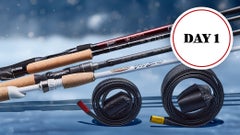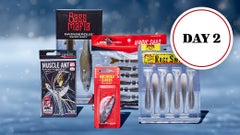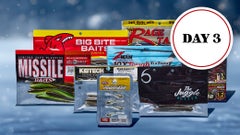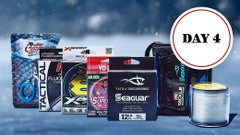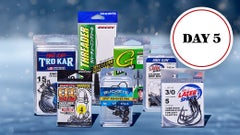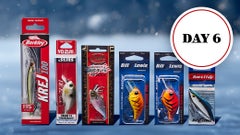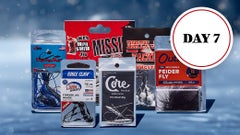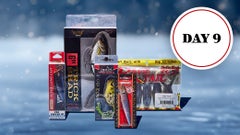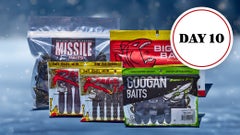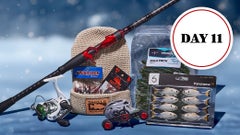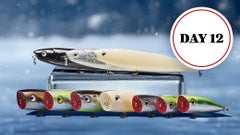Aaron Britt Wins Clear Lake Western Rayovac
Aaron Britt's Winning Pattern, Baits & Gear
Britt had fished a Tournament of Champions event at Clear Lake the week before the Rayovac so he was pretty in tune with the bite. In addition, he already had a win and two runner-up finishes at Clear earlier this year in team events. "Unless you were throwing a crankbait or punching grass, you weren't catching anything of size," he said. "Guys were catching 2- to 3-pounders on worms and drop shots, but there are so many 6- to 10-inch fish in there right now you had to have something else going." He'd spent six days in the row on the water for the TOC, during which he threw a Carolina Rig, square-bill crankbait and a lipless rattle bait, then took four days off before returning to prep for the Rayovac Series. "I basically started over," he said. "Some guys were flipping grass, but you can put your head down doing that and look up two hours later and realize you've only covered 200 yards. In two hours with a crankbait, I could cover a lot more water and I figured I'd run into more fish doing that than flipping grass." He could decent bags in the 20-pound range during practice and had settled on a few areas and spots that he intended to fish once the competition started. On the day before the tournament, he was planning to stay off the water, but a co-angler friend of his wanted some extra prep time. "I didn't feel like I needed to keep catching some of those fish," he said. "I found this area on the last day, though. I pulled up, made four casts and caught four over 6 pounds. I pulled off that spot and got off the water at noon."
Competition:
Britt headed back to the spot that produced the big bites on the last day of practice to start the tourmament. He was boat number 23 and was the first - and only - boat there. He went an hour without a bite, making casts from every conceivable angle. Meanwhile, his co-angler had caught three with a square-bill over 15 feet of water. "I was spun out already," he said. He moved to another spot and loaded the boat with a 4, a 5 and a pair of 6 1/2-pounders - all cranking - that gave him a limit for about 24 pounds by 10:30 a.m. "It was an area where I can generally catch a limit of 3s or 4s," he said. "When I caught those fish, I knew I had something going." He left that area knowing he'd need to catch another big one in order to cull and he didn't want to cull for ounces. He tried a couple spots that he said he could make a handful of casts on and find out quickly if there were bass around. "The rest of the stuff were areas or stretches," he said. He returned to his starting spot and connected with a 8-pounder, which got him to 29-00 and the day-1 lead. "I was stoked to catch 29," he said. "I only got eight bites and they were all good ones with one exception. Catching 29 coming out of the gates was helpful because I knew I didn't have to catch 29 every day to win. If it were March or April, you'd need 33 a day to win, but after being there for two weeks, I knew how it was to catch a fish over 6 pounds." It was the second-heaviest bag weighed during a Clear Lake Rayovac since 2011, surpassed only by Jason Borofka's 32-01 sack in the September 2013 event.
He went back to the area that kicked out his best fish on day 1 to start day 2. After boating a 2-pounder, he popped matching 6-pounders, then left to start his rotation through other areas. He wasn't able to trigger any late-day kickers and wound up bringing 18-11 to the scale. It wasn't enough to keep him in the lead, but he was a mere 4 ounces behind Kyle Grover entering the final day. Britt had a front-row seat to watch a local catch a 9-pounder on a jig as he pulled up to his starting spot on the final day, the same spot he started day 1. "They weighed it and threw it back, so of course, I pull out a jig," he said. "I caught a 1 1/2-pounder on it, but the first fish I caught each day was small." By then, he'd narrowed down his fishing spots to three areas. He didn't catch any other keepers off his first stretch, so he went back to the area that produced on day 1 and cranked up three 2 1/2-pounders. He then called an audible and stopped on an area that he hadn't practiced or fished previously in the tournament. "It's a big community hole and I caught a 5 1/2 there to get me to 18 pounds," he said. With an hour left in his day, he made another gut call to go back to his best area. "Usually, I'd just go back and forth down this stretch, but when I got to the spot where I'd normally turn around, I went a little further and caught a 8-pounder," he said. "That fish won me the tournament. "I had five or six spectator boats following me around and few of them were by close buddies so it was special to have them there for that. I almost kissed my co-angler I was so excited." He went into the final day thinking he needed 25 pounds to have a shot to win. "When I caught that big one, I knew I had over 20, but I live on this lake and you're never sure unless you have 30."
Winning Pattern:
With the water temperature higher than normal, Britt said the "fish were just as confused as the fishermen. "The fish are sitting out and wanting to move up, but the water temperature made it tough for them. The fish are still in their summer patterns and they didn't know if they were supposed to suspend or move up. You had to stick with what you had confidence in." An algae bloom was evident in some parts of the lake, but Britt said it wasn't as dramatic as some made it out to be. "There were a few areas that were bad, but it wasn't unfishable bad. It was an inch of color on top. You could dip your hand in the water and it would just the color around. I think that scared a lot of people off. On some portions of the lake, it acts like a canopy. The sun still gets through." He spent his whole tournament on the mid-lake section bouncing among four to six areas and spots. "They all had rock and hard bottom," he said. "The main area was basically a long ledge, about 300 yards long down the highway 20 side. It's a community hole and usually, people go down once and leave. I'd go up and down and kept sticking with my guns. I figured if I made enough casts at the right angle, one would hit it eventually. "On the other areas, there were big boulder rocks and the key was being close 20 feet of water. On six of the fish I weighed in, my crankbait was caught in the rocks. I'd pop the line to get it loose and as soon as it would come off the rock, they'd eat it."
Winning Gear Notes:
Cranking gear: 7'11" medium-heavy iRod Fred's Crank Launcher casting rod, unnamed casting reel (6.4:1 gear ratio), 12-pound Seaguar InvizX fluorocarbon line, SPRO Little John DD (spooky shad, clear chartreuse), Norman DD-22 (Clear Lake crystal), Damiki DC-400 (ayu). He likes the SPRO plug because it's a silent bait and with all the pressure on the lake and clear water, he didn't feel rattles made a huge difference. "On top of that, I've never seen a baitfish with rattles in it," he said. He ran out of Little John DDs on the second day of the tournament, but his dad found some at a local tackle store and brought some to him in time for the final day. "I caught the big fish at the end of day 3 on it," he said. He changed every stock hook to a #2 Gamakatsu EWG trebles.
Main factor: "Putting my head down and going, and having faith in those areas and not panicking. I knew if I made enough casts, the fish were around and moving up and down. I knew I'd trigger them to eat and eventually there'd be good ones. I usually don't have that type of patience."
Performance edge: "The rod helped me a lot. Unless you fish a lot, you don't realize the effect the right rod can have for you. The cranks were key, too, but the rod allowed me to get that bait out there as far as I needed to."
Clear Lake Winning Pattern Bassfan 10/14/14 (Todd Ceisner)
Patrick Spencer's Pattern, Baits & Gear
"Some of it was on top, but it was dying off," he said. "It was hard to see. It was beneath the surface a foot or so. A lot of guys would write it off because it was dying, but I knew they were still in there." It was a breezy start to day 1 of the tournament and his crankbait program yielded three 3-pounders by 10:30. He moved to a deep spot where he'd gotten a bite in practice and fished it for 20 minutes, but left without another keeper. "I ran to some grass where I'd had two bites in practice and within five minutes, I caught a 4 1/2," he said. "I knew they were in there so I stayed there. I caught five for 24 pounds in an hour." He eventually left since no one else was fishing that area in hopes he could return to it later on. His 24-13 had him in 4th place after the opening day. There was no wind to speak of to start day 2 so Spencer went back to his productive grass and went all morning without a bite. "I knew they were there and that kept me there all day," he said. "I had three that came off that would've won it for me. My timing was a bit off. I think I was in there too long, but I knew if I could survive and make it to Saturday, I could come back and catch them." He didn't finish his limit until after 3:30 and came in with 15-13 to make the cut in 9th place. On the final day, he threw a square-bill until 10 a.m. before jumping to his green stuff. "Sure enough, 20 minutes after I got there, I caught an 11-09," he said. "It's the biggest fish I've ever caught. I pitched in there and let the bait soak quite a bit. I remember looking back at my co-angler, then picking my rod up and it felt heavy. I set the hook as hard as I could and it didn't move. I told my co-angler it was a giant and the fish came up and tail-flapped on the mat and I reeled him in as fast as I could." He added a couple smaller fish, then caught an 8 1/2-pounder at 1:30 and finished his limit at 2. "That spot was crazy," he said. "I had two bites there in practice, but I didn't set the hook so I had no clue how big they were. I only had five bites all day the last day." He focused on staying in 6 to 8 feet of water and noted the fish would take his bait on the fall in practice and on day 1, but he had to let it go to the bottom on the final two days. "They were biting weird," he added. "It was like they were buried in the grass and not moving."
Flipping/Punching gear: 7'5" extra-heavy G. Loomis GLX casting rod, Shimano Core casting reel, 65-pound Stren Super Sonic braided line, 1-oz. Eco Pro Tungsten flipping weight (black), Paycheck Baits punch skirt (black/red), 3/0 Gamakatsu super heavy cover flippin' hook, Berkley Havoc Craw Fatty (black red flake). His crankbait of choice was a Lucky Craft SKT MR square-bill (chartreuse shad).
Main factor: "Keeping my head on straight and staying mentally focused. I saw guys flipping grass for an hour and then they'd leave if they didn't get a bite. I'd go two or three hours without even a hit. I could've lost my head. A lot of guys would've spun out, especially Friday when I lost those key fish without having a limit. I just kept my head down and told myself that on any flip it could happen. I knew I needed just five bites. "
Performance edge: "The reel and line were really key. I've never broken one off with that line and I was setting the hook as hard as I could. Not breaking those off is really key. A good hook is so important also, especially when you set the hook on an 8 and it runs on slack and you keep it on."
Clear Lake 2-3 Patterns Bassfan 10/15/14 (Todd Ceisner)
Justin Kerr's Pattern, Baits & Gear
Flipping/Punching gear: 7'11" heavy-action Evergreen Morizo Flip casting rod, unnamed casting reel (7.1:1 gear ratio), 25-pound Evergreen Bass Seil fluorocarbon line, 1-oz. Kanji tungsten flipping weight (black), Paycheck Baits punch skirt (green-pumpkin), 4/0 Gamakatsu heavy cover flippin' hook, Kinami Pyscho Dad (green-pumpkin blue). He had punching rods rigged with 1 1/2-oz. and 1/2-oz. weights, but he said 90 percent of his grass fish came on the 1-oz. setup.
Crankbait gear: 6'8" medium-light Evergreen Servil casting rod, same reel, 14-pound Evergreen Bass Seil fluorocarbon line, Evergreen Wild Hunch (silent) crankbait (shad).
Carolina rig gear: 7'7" medium-heavy Evergreen Strikemaster casting rod, same reel, same line as crankbait, 1/2-oz. egg sinker, 4/0 Roboworm Rebarb hook, 7" straight-tail Roboworm (margarita mutilator).
Main factor: "Moving a little faster than normal."
Performance edge: "My HydroWave was pretty important. I had the volume turned all the way up and in certain places they just came to the boat with it on. At certain times of the year and at certain places it works."
Clear Lake 2-3 Patterns Bassfan 10/15/14 (Todd Ceisner)

















